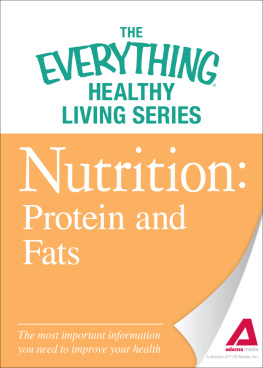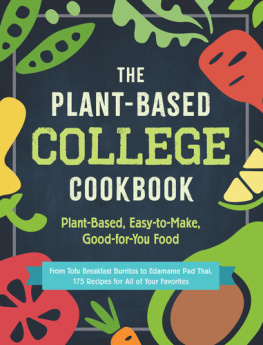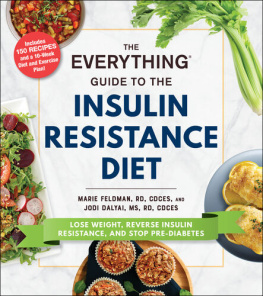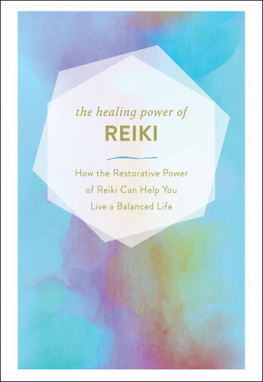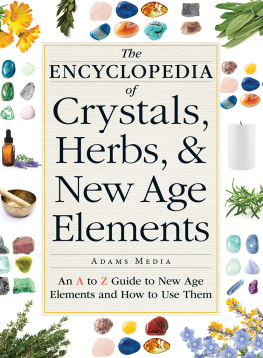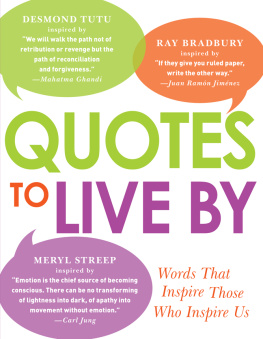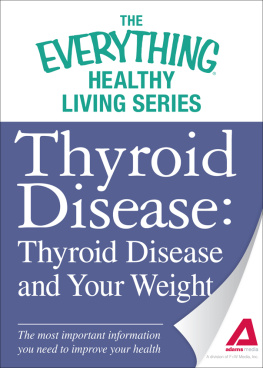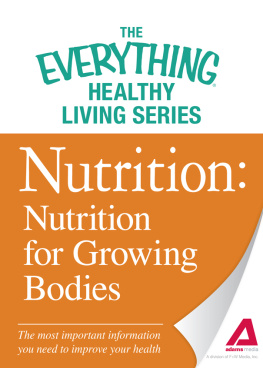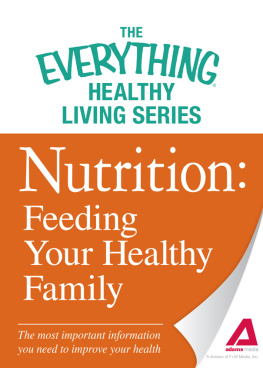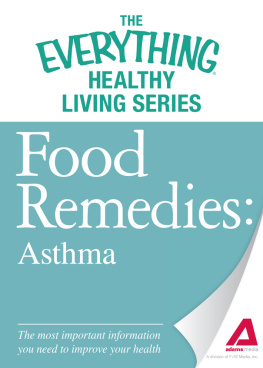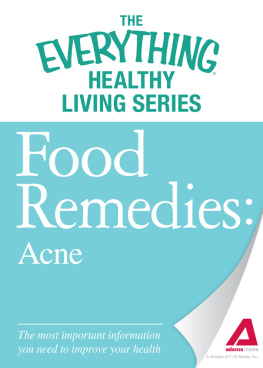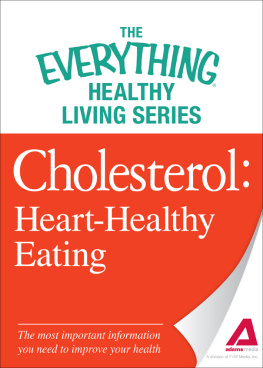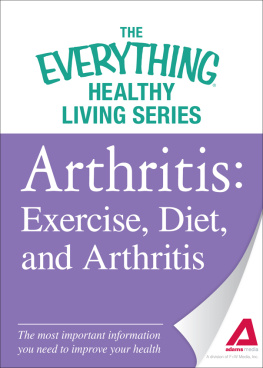Adams Media, an imprint of Simon & Schuster, Inc.
For more than 10 years, millions of readers have trusted the bestselling Everything series for expert advice and important information on health topics ranging from pregnancy and postpartum care to heart health, anxiety, and diabetes. Packed with the most recent, up-to-date data, Everything health guides help you get the right diagnosis, choose the best doctor, and find the treatment options that work for you.
The Everything Healthy Living Series books are concise guides, focusing on only the essential information you need. Whether youre looking for an overview of traditional and alternative migraine treatments, advice on starting a heart-healthy lifestyle, or suggestions for finding the right medical team, theres an Everything Healthy Living Book for you.
Nutrition
Food is everywhere. Every street has a restaurant, every event has a concession stand, and every commercial is dripping with cheese. Billboards, newspapers, and the Internet are constantly trying to sell you food. And you want to buy it. But is whats out there really something you need? Does it do your body any good? Is it making you healthy and strong? And what about the kids? How are they handling being inundated with constant food opportunities? Are they growing up healthy, lean, and fit? If they live in America, theres a good chance they arent.
Poor nutrition is a growing problem in the United States. Its not that we dont have enough to eat. Its that we have too much of the wrong stuff to eat. You probably already know you should lay off the fast food and pick up an apple instead of that doughnut. But have you ever wondered what healthier foods could really do for you?
Did you know that eating the right carbohydrates can give you ongoing energy? Did you know that bright fruits and vegetables can help protect you against cancer? Did you know that eating right at an early age can protect kids from food allergies?
Food is fuel. It can be delicious fuel, but it can also be the wrong fuel. Like putting diesel fuel in a gasoline engine, people often choose the wrong food. Without the proper fuel and regular intervals throughout the day, you sputter and stall and will likely need a tuneup, or worse, a complete overhaul. Getting the right fuel is not mysterious, difficult, expensive, or time-consuming. The Everything Healthy Living Series: Nutrition will show you exactly what, when, and how much you need to eat to get back on the road to good health.
Focusing on lifestyle changes instead of following a specific diet is the ticket to achieving optimal health, decreasing your risk of illness, increasing your energy level, improving your quality of life and well-being, and reducing your medications. In this series, youll find everything you need to know to get your family on the road to life-long good health.
If youd like to learn more about nutrition, check out The Everything Guide to Nutrition, available in print (978-1-4405-1030-4) and eBook (978-1-4405-1159-2) formats.
The Power of Protein
Protein is one of the macronutrients and most important sources of calories to be consumed at each meal, including snacks. Its power to slow digestion and regulate blood sugars, hunger, and energy levels can improve your productivity and performance and you wont need to take so many coffee breaks. This is especially true during that afternoon drop, when many of us reach for a quick fix of processed foods or empty calories. Luckily, we have plenty of protein sources from plants, animals, and dairy products to save us from malnutrition and help us reach our potential.
The Role of Protein in a Healthy Diet
Protein builds and maintains muscles, organs, connective tissues, skin, bones, teeth, blood, and your DNA (deoxyribonucleic acid). It helps the body heal when it is sick, wounded, or depleted. Without protein, even mild exercise would weaken you to the point of exhaustion.
Protein contributes to the formation of enzymes. Almost all reactions that occur in the body, such as digestion, require enzymes. Enzymes are catalysts to these reactions, increasing the rate at which they occur.
There is protein in your blood, called antibodies. They serve as your bodys immune responders. They bind with and fight foreign invaders, such as bacteria or toxins. Protein is found in hormones, your bodys chemical messengers. Hormones help regulate the bodys activities, maintaining balance or homeostasis.
Amino Acids
Protein is composed of twenty amino acids. These acids link together in chains to form the variety of proteins your body needs. The length and shape of the chain determines the proteins structure. Of the twenty amino acids, eleven of them are made by your body. These eleven acids are called nonessential because you do not need to consume them. The remaining nine amino acids are called essential, and it is important that you eat these every day. Getting all nine essential amino acids is not hard, especially if you eat meat. Animal foods (which include meat, eggs, and dairy products) contain the largest concentration of protein. Animal protein is considered complete, because it contains all nine essential amino acids.
Essential
Eating complementary protein means consuming both beans and grains every day. The beans can be pinto, kidney, black, lentils, garbanzo, split peas, or peanuts. Grains should be whole, including brown rice, whole-wheat pasta, bread, crackers, or tortillas. Sesame seeds also complement the protein of beans.
Plant foods also contain proteins, but few plants contain complete protein. This is one of the challenges of vegetarianism, because to stay healthy you must consume enough foods with the right mixture of amino acids. It sounds complicated, but grains, nuts, and legumes contain the proteins that are not found in other plants, so adding a variety of these to your diet does the trick.
Plant foods eaten in combination to create complete protein are called complementary proteins. When these foods are eaten over the course of a day, protein intake is complete. Protein derived from complementary plant proteins is considered a healthy alternative, and by many people, a superior one. Eating such combinations of plant foods not only completes the protein, but also provides other nutrients vital to good health as well, most notably fiber, vitamins, and minerals. And most plants do all that without saturated fat.
Cooking Protein
Cooked protein is also referred to as denatured. When denatured, protein changes its structure and stops functioning. In denaturation, the amino acids loosen, recoil, and tighten, which changes the appearance, texture, and flavor of the protein. If you watch an egg being cooked, you can see the denaturation happen within a minute or two as the albumen turns white.
Cooking protein does not necessarily require heat. Acid will denature protein, as it does in the Latin American dish ceviche, in which seafood is marinated in lime. Salt is used to cook protein in cured meats, such as ham, sausages, and salt cod. Pickled meats combine acid and salt for a double-whammy cooking method. Even agitation can denature protein, as in the whipping of eggs. In this case prolonged agitation changes the eggs structure, making it safe to eat. Meringue demonstrates this effect on the egg white, while yolks and whole eggs get this treatment in mayonnaise and emulsified salad dressings, such as those used in Caesar salad.

